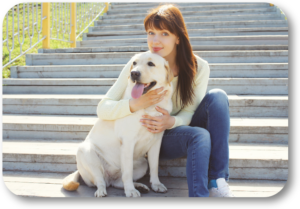I was at a new Home Dog Training Client last week in Johns Creek helping him with his two-year old Labradoodle named Buddy. Buddy was mostly a good dog except for some annoying tendencies that included listening when he wanted, jumping on guests coming into the house, stealing food off your plate, and always pulling on the leash during walks. From a “dog training perspective”, none of these were “earth shattering” problems.

After a few hours, I had trained my client how to be “the adult in the room” and worked with Buddy to let him know that it was now time to always respect his owner and look to him for direction and leadership. My client was happy because he now had a great dog and Buddy was happy because he now understood what he needed to do. It was a “win-win” and a great training.
Even though many people tell Robin and me that they are amazed at the results they were able to achieve with their dog, our goal is not to “amaze” but to “educate”. We are often called into our clients’ homes because they have “had it” with their dogs’ behavior and are frustrated that they can’t make their dogs behave and listen.
For our clients to be successful and achieve the results they desire, Robin and I must “educate” and not “amaze”. The initial subject that we discuss with our clients regarding their ability to successfully control their dogs is their dog’s “thought process”. To put it another way, “What is my dog thinking?”.
This may not be the first thing you would think of as part of “dog training”. In reality, it is key to proper dog training. Without understanding your dog’s thought process, you will never get him to do the “normal doggie things” like come, sit, stay, walk, etc. When you don’t understand how your dog thinks, your actions will often confuse him and cause him to act inappropriately.
So, how does your dog think? The best way to answer this question is to understand the concepts of “one to one” and “one to many”. Let’s look at a comparative example.
Let’s say you are in college, and you walk into a philosophy class. The professor asks the question “What is the meaning of life?”. For the next forty-five minutes multiple students raise their hands and propose different answers.
You sit back and listen to all the answers provided. At the end of the class your notes show that there may have been thirty or forty different answers to the professor’s original question of “What is the meaning of life”. Although you may not agree with all of them, you can accept the probability and validity of all of them. There can be “many right answers” to any one question.
You now proceed to a calculous class. The professor writes an equation on the board and asks the class for the answer. You raise your hand and say that the answer is 8x. The professor says you are wrong. The answer is 4y. Your answer was wrong, and his answer was correct. Even if another student had proclaimed that the answer was 9Z, it would not matter. There was only one answer to the calculous equation and the answer was 4y. In calculus there is only “one right answer” to any question.
We (humans) can understand both cognitive processes. There can be many right answers to a single question or one right answer to a single question. Dogs do not have this ability. They can only understand that there can be one right answer to a single question.
This means that whenever you ask your dog to do something or set a rule regarding what they can not do, the outcome must always be the same. If you give your dog a command to sit, the only thing he can do next is sit. If you don’t want your dog to jump on people, he can never jump on anyone at any time for any reason. Think of your commands and rules as stop signs. Whenever you see the stop sign, you stop. No matter what else may be happening, you must stop.
This is how you must create your commands and rules. Your dog’s cognitive process is singular and linear. Their thought process does not employ the logic component that can be utilized in our thought.
So, dogs think simply and linearly. Whenever you ask them to do something or implement a behavioral rule, the outcome you require must always be the same. This is how our dogs see the world around them and this is the thought process that they utilize within their interactions.
Please call Robin or me at (770) 718-7704 if you need any dog training help. We are blessed to have been your local dog training experts for over sixteen years. We have trained over 5,000 great dogs and loving families and are ready to help you.

Follow Us!